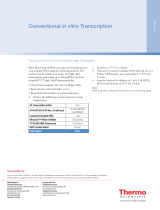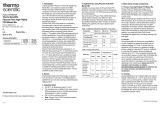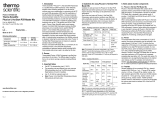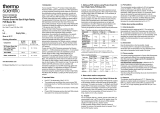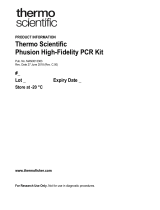Page is loading ...

PRODUCT INFORMATION
Thermo Scientific
Replicator RNAi Kit
#F-610
Lot _ Expiry Date _
Store at -20°C
www.thermoscientific.com/onebio
2
Rev.1

3
CONTENTS
COMPONENTS OF THE KIT ...................................................................................................... 4
STORAGE ................................................................................................................................... 4
1. INTRODUCTION ..................................................................................................................... 4
2. APPLICATIONS ...................................................................................................................... 4
3. METHOD OVERVIEW ............................................................................................................. 5
4. TEMPLATE PREPARATION BY PCR .................................................................................... 5
4.1 Target preparation.............................................................................................................. 5
4.2 Primer desing ..................................................................................................................... 5
4.3 PCR .................................................................................................................................... 5
4.3.1 Cycling conditions ........................................................................................................ 6
4.4 Purification ......................................................................................................................... 7
5. dsRNA PRODUCTION SETUP ............................................................................................... 8
6. PURIFICATION OF dsRNA ................................................................................................... 10
7. QUANTIFICATION AND STORAGE OF THE dsRNA .......................................................... 11
8. TROUBLESHOOTING .......................................................................................................... 12
9. REFERENCES ...................................................................................................................... 13
4
COMPONENTS OF THE KIT
Component #F-610
40 rxns
Phusion High-Fidelity DNA Polymerase (2 U/µL) 25 µL
10 mM dNTP mix 20 µL
5X Phusion HF buffer 1.5 mL
Lambda control DNA (0.5 ng/µL) 20 µL
Control Primer mix (25 µM each) 20 µL
Phi6 RNA Replicase 60 µL
T7 RNA Polymerase 60 µL
Pyrophosphatase 40 µL
10X dsRNA Synthesis Buffer 250 µL
5X NTP mix 400 µL
50 mM MnCl2 500 µL
8 M LiCl 2 mL
STORAGE
The Thermo Scientific Replicator RNAi Kit is shipped in gel ice. Upon arrival, store the kit
components at ‑20°C. The 10X dsRNA Synthesis Buffer contains DTT, which may lose its
reducing capability when stored or handled inappropriately. LiCl solution can also be stored at
room temperature.
1. INTRODUCTION
Replicator™ RNAi Kit is a highly efficient and specific tool for generating double-stranded RNA
for gene silencing experiments. The kit utilizes a new technology where dsRNA is produced by
combined in vitro transcription and replication reactions. Both reactions take place in a single
incubation step. The DNA template for the dsRNA synthesis is produced by PCR using
Thermo Scientific Phusion High-Fidelity DNA Polymerase. Phusion™ DNA Polymerase’s high
speed, fidelity and robustness ensure correct starting material for the dsRNA production and
enable amplification of long templates up to 10 kb. The PCR product is transcribed into single-
stranded RNA by T7 RNA Polymerase. The ssRNA is then replicated into double-stranded
RNA by Phi6 RNA Replicase1–3 in the same incubation step. Due to the unique combination of
complementary polymerase activities, the produced dsRNA is perfectly duplexed. The reaction
yield is high. The kit contains sufficient reagents for producing up to 2.5 mg of dsRNA in a total
volume of 2 mL. The yield depends on the target sequence.
2. APPLICATIONS
dsRNA produced with this kit is a suitable substrate for enzymes such as RNase III and Dicer,
which cut the dsRNA into small interfering RNAs and thereby produce a pool of siRNA
targeted for a chosen sequence. Such siRNA pools have successfully been used in gene
silencing experiments4–6.

5
3. METHOD OVERVIEW
The dsRNA is synthesized by combined in vitro transcription and replication from a DNA
template.
The DNA template for the dsRNA synthesis is produced by PCR using Phusion High-Fidelity
DNA Polymerase. The PCR primers are designed so that the resulting PCR product contains
the target sequence flanked by T7 promoter sequence at one end and Phi6 RNA Replicase
promoter sequence at the other end.
The PCR product is purified and transcribed into single-stranded RNA by T7 RNA Polymerase.
This ssRNA is replicated into double-stranded RNA by Phi6 RNA Replicase in the same
incubation step. 4. TEMPLATE PREPARATION BY PCR
4.1 Target preparation
With the Replicator RNAi Kit, targets ranging between 100 bp and several kilobases in length
can be amplified. The template DNA for the PCR can be either genomic DNA, plasmid DNA or
cDNA produced using reverse transcriptase enzyme.
4.2 Primer desing
The primers have to be designed separately for each target sequence. RNA polymerase
promoter sequences needed for the dsRNA synthesis are added to both sides of the target
sequence using PCR. The PCR primers are designed so that they contain RNA polymerase
promoter sequences at their 5’ ends. Thus in the PCR product, RNA polymerase promoter
sequences flank the target sequence. In addition to promoter sequences, each primer should
contain 17-22 nucleotides of target gene-specific sequence at the 3’ end. The PCR
amplification primers are illustrated bellow. The promoter sequences are underlined. The first
nucleotides to be incorporated into the final dsRNA product at each end are marked in red.
Target genespecific sequences at the 3’ end of the primers are denoted by N(17–22).
Amplification primers
Forward primer 5’ TAATACGACTCACTATAGGGN(17-22) 3’
Reverse primer 5’ GGAAAAAAAN(17-22) 3’
4.3 PCR
PCR reactions should be set up on ice. It is critical that the PhusionDNA Polymerase is the last
component added to the PCR mixture, since the enzyme exhibits 3’→5’ exonuclease activity
that can degrade primers in the absence of dNTPs. Phusion DNA Polymerase produces blunt
end DNA products.
The optimal amount of enzyme depends on the length of the PCR product and the amount of
template used. Normally, 1 unit of Phusion DNA Polymerase per 50 µL reaction volume gives
good results. Optimal enzyme amount can range from 0.5–2 units per 50 µL reaction
depending on the amplicon length and difficulty. Do not exceed 2 units per 50 µL reaction. For
optimal results, use 200 µM of high quality dNTPs included in the kit.The amount of template
depends on the complexity of DNA. General guidelines for low complexity DNA (e.g. plasmid,
lambda or BAC DNA) are: 1 pg–10 ng per 50 µL reaction volume. For high complexity
genomic DNA, the amount of DNA template should be 50–200 ng per 50 µL reaction volume.
If cDNA synthesis reaction mixture is used as a source of template, the volume of the template
should not exceed 10% of the final PCR reaction volume. PCR and dsRNA production
efficiency can be controlled using the accompanied l control DNA and control primers (see
Tables 1 and 2).
6
Table 1. Pipetting instructions for the PCR reaction.
Component (in order) 50 µL rxn Final conc.
H2O add to 50 µL
5X Phusion HF buffer 10 µL 1X
10 mM dNTPs 1 µL 200 µM each
Forward primer X µL 0.5 µM
Reverse primer X µL 0.5 µM
Template DNA X µl
Phusion DNA Polymerase 0.5 µL: 0.02 U/µL
Table 2. Pipetting instructions for the control PCR reaction.
Component 50 µL rxn
H2O 33.5 µL
5X Phusion HF buffer 10 µL
10 mM dNTPs 1 µL
Control primer mix (25 µM each) 1 µL
λ control DNA (0.5 ng/µL) 4 µL
Phusion DNA Polymerase 0.5 µL
4.3.1 Cycling conditions
Due to the nature of Phusion DNA Polymerase, optimal reaction conditions may differ from
standard enzyme protocols. Phusion DNA Polymerase tends to work better at elevated
denaturation and annealing temperatures due to higher salt concentrations in its buffer.
Table 3. Cycling instructions.
Cycle step Temp. Time Cycles
Initial denaturation 98°C 30 s 1
Denaturation 98°C 5-10 s
25-35
Annealing 45-72°C 10-30 s
Extension 72°C 15-30 s/1 kb
Final extension 72°C
4°C
5-10 min
hold 1
Table 4. Cycling instructions for the control reaction.
Cycle step Temp. Time Cycles
Initial denaturation 98°C 30 s 1
Denaturation 98°C 10 s
34
Annealing, extension 72°C 35 s
Final extension 72°C
4°C
5 min
hold 1

7
Initial denaturation
30 s initial denaturation at 98°C is recommended for most templates. Some templates may
require longer initial denaturation time and the length of the initial denaturation time can be
extended up to 3 minutes.
Denaturation
Keep the denaturation as short as possible. Usually 5–10 seconds at 98°C is enough for most
templates.
Primer annealing
The optimal annealing temperature for Phusion DNA Polymerase may differ significantly from
that of Taq-based polymerases. For best results, calculate the Tm for the target gene-specific
sequence of the primers. Always use the Tm calculator and instructions on our website
(www.thermoscientific.com/pcrwebtools) to determine the Tm values of primers and optimal
annealing temperature.
Phusion DNA Polymerase has the ability to stabilize primer-template hybridization. As a basic
rule, for primers >20 nt, anneal for 10–30 seconds at a Tm +3°C of the lower Tm primer. For
primers ≤20 nt, use an annealing temperature equal to the Tm of the lower Tm primer.
If necessary, use a temperature gradient to find the optimal annealing temperature for each
template-primer pair combination. The annealing gradient should extend up to the extension
temperature (two-step PCR).
A 2-step protocol is recommended when primer Tm values are at least 69°C (> 20 nt) or 72°C
(≤ 20 nt) when calculated with our Tm calculator.
In the 2-step protocol the combined annealing/extension step should be performed at 72°C
even when the primer Tm is >72°C.
Extension
The extension should be performed at 72°C. Extension time depends on amplicon length and
complexity. For low complexity DNA (e.g. plasmid, lambda or BAC DNA) use extension time
15 s per 1 kb. For high complexity genomic DNA 30 s per 1 kb is recommended.
4.4 Purification
Following PCR, the size and purity of the PCR product should be examined on an agarose gel.
The PCR product can be purified using either phenol/chloroform extraction followed by
standard ethanol precipitation or commercially available DNA purification columns.
Alternatively, the PCR product can be gel-purified if necessary. Resuspend the DNA in RNase-
free water or 10 mM Tris-HCl, pH 8.0–8.5. The concentration of the PCR product can be
determined by spectrophotometric measurement at 260 nm or estimated from an agarose gel.
The expected length of the PCR product from the control reaction is 881 bp.
8
5. dsRNA PRODUCTION SETUP
dsRNA is produced in a single reaction combining DNA transcription and replication of the
ssRNA into dsRNA. The dsRNA synthesis reaction is illustrated in Figure 1.
Figure 1. dsRNA synthesis reaction.
The reaction volume can be scaled up from the 50 µL described in Table 5. It is recommended
to perform a single 20–50 µL pilot reaction before scale up to confirm all reaction conditions are
correct. Use of RNase inhibitor is not normally necessary because ssRNA produced byT7 RNA
Polymerase is immediately replicated into more stable dsRNA by Phi6 RNA Replicase.

9
Table 5. Pipetting instructions for the dsRNA reaction.
Component (in order) Volume/50 µL rxn Final conc.
RNase-free water add to 50 µL
10X dsRNA Synthesis Buffer 5 µL 1X
5X NTP mix 10 µL 1X
DNA template X µL 10-40 ng/µL
MnCl2 (50 mM) 1.5 µL 1.5 mM
Pyrophosphatase 1 µL
T7 RNA Polymerase 1.5 µL
Phi6 RNA Replicase 1.5
1. Thaw the reagents (10X dsRNA Synthesis Buffer, 5X NTP mix and MnCl2) at room
temperature immediately before use. Keep the 10X dsRNA Synthesis Buffer and MnCl2
at room temperature until use. Store the ribonucleotides and enzyme solutions on ice until
use.
2. Prepare the dsRNA synthesis reaction by combining the reaction components in the
following order. Reaction assembly should be done at room temperature because the
dsRNA synthesis buffer contains spermidine that can precipitate nucleic acids on ice. Use
2–5 µg of DNA template per 50 µL reaction. Set up a separate reaction for each template of
interest. It is advisable to perform a concomitant control reaction using the control PCR
product to test the reaction conditions.
3. Mix the components thoroughly. Spin briefly to collect the reaction mixture at the bottom of
the tube.
4. Incubate at 35°C for 2–4 hours using e.g. a thermal cycler. The reaction can also be
allowed to proceed overnight. Overnight incubation doubles the yield of some dsRNAs.
5. It is recommended to examine the dsRNA product by standard agarose gel electrophoresis.
Take a 5 µL sample from the dsRNA reaction and dilute it 20- to 100-fold before the gel
electrophoresis. The gel and electrophoresis buffer should be prepared with RNase‑free
water. Common DNA markers can be used to estimate the length of the dsRNA product
with sufficient accuracy. The control reaction should yield a dsRNA of 864 bp (Figure 2).
Occasionally, some ssRNA is visible after the reaction. ssRNA migrates on the gel at
approximately half the size of the corresponding dsRNA.
10
Figure 2. Various gene-specific dsRNA fragments generated using the Replicator RNAi Kit.
PCR-amplified fragments of various sizes were used as template DNA. 0.1 µL from each
reaction mixture was loaded on an agarose gel.
M – HaeIII-digested Phi174-DNA
1 - dsRNA specific to 150 bp sequence of lambda DNA
2 - dsRNA specific to 210 bp sequence of Furin gene
3 – dsRNA specific to 281 bp sequence of Erk ½ kinase gene
4 - dsRNA specific to 430 bp sequence of Caspase-3 gene
5 - dsRNA specific to 864 bp sequence of lambda DNA
The yield of dsRNA from a 50 µL reaction is typically 20–60 µg, depending on the target
sequence and length. The dsRNA synthesis reaction can be stored at -20°C or -80°C before
purification. Storage of unpurified dsRNA may cause the formation of a white precipitate. The
precipitate does not contain RNA and can be removed by centrifugation before purification.
6. PURIFICATION OF dsRNA
The need for purification depends on the downstream application. Double-stranded RNA can
be purified from contaminating reaction components using either selective LiCl precipitation or
nuclease digestion. LiCl solution is included in the kit. Both purification methods may require
an additional NTP removal step (e.g. gel filtration), depending on the use of the dsRNA
product.
LiCI precipitation
LiCl precipitation selectively removes template DNA and ssRNA from the reaction. The dsRNA
synthesis reaction is first precipitated with 2 M LiCl which precipitates all or most of the ssRNA
present. The supernatant containing the dsRNA is then exposed to a second precipitation step
using 4 M LiCl which efficiently precipitates dsRNA leaving template DNA and most NTPs in
the supernatant. Keep the reactions on ice while pipetting.
1. Add 1/3 volume of 8 M LiCl to the dsRNA synthesis reaction in a 1.5 mL microcentrifuge
tube and mix. The final LiCl concentration is 2 M.
2. Incubate at -20°C for 30 minutes.
3. Centrifuge at 14 000 rpm in a microcentrifuge for 20 minutes at 4°C.
4. Carefully separate the supernatant from the pellet. The dsRNA remains in the supernatant,
while ssRNA is precipitated.
5. Add 1/2 volume of 8 M LiCl to the supernatant. The final LiCl concentration is 4 M. This
step precipitates dsRNA.
6. Incubate at -20°C for 30 minutes.
7. Centrifuge at 14 000 rpm for 20 minutes at 4°C.

11
8. Remove the supernatant. The dsRNA pellet is not necessarily visible. Wash the pellet with
500 µL of 70% (v/v) ethanol.
9. Centrifuge at 14 000 rpm for 5 minutes at 4°C.
10. Carefully remove the ethanol without disturbing the pellet.
11. Air-dry the pellet for 5–10 minutes at room temperature and resuspend the dsRNA in
50 µL of RNase-free water or TE buffer (10 mM Tris-HCl, pH 8.0, 1 mM EDTA). Be careful
not to over-dry the pellet, as it may become difficult to resuspend the dsRNA.
Nuclease treatment
Alternatively, the template DNA and ssRNA can be removed from the synthesis reaction by
DNase (RNase-free) and RNase digestion. Perform the reactions according to the
manufacturer’s instructions. Make sure to choose nucleases that do not degrade double-
stranded RNA.
Gel filtration
After LiCl precipitation or nuclease treatment, the dsRNA may be further purified using
commercial gel filtration columns to ensure that all NTPs are removed from the reaction.
Removing remaining NTPs will allow accurate spectrophotometric quantitation of dsRNA.
Analysis by gel electrophoresis
It is recommended to analyze the purified dsRNA using agarose gel electrophoresis. The size
of dsRNA can be estimated comparing to common DNA markers.
7. QUANTIFICATION AND STORAGE OF THE dsRNA
The concentration of dsRNA can be determined spectrophotometrically at 260 nm. In order to
obtain accurate quantification, the dsRNA has to be free from contaminating NTPs. Measure
the absorbance at 260 nm from a 1:4 or 1:20 dilution. For accurate results, make the dilutions
using 10 mM Tris-HCl, pH 7.5. The concentration of RNA can be calculated as follows: 1 A260
= 40 µg dsRNA per ml. Store the purified RNA at -20°C or -80°C.
Purity of RNA
The ratio of absorbances at 260 and 280 nm (A260/A280) provides an estimate of the purity of
RNA with respect to contaminants that absorb in the UV region, such as proteins. Pure RNA
should exhibit an A260/A280 ratio of 1.9–2.1 in 10 mM Tris-HCl, pH 7.5. The A260/A280 ratio
is influenced by pH and since water is not buffered, it is recommended to measure the
absorbance of RNA sample in 10 mM Tris-HCl, pH 7.5.
12
8. TROUBLESHOOTING
PCR
Problem Cause and Solution
No product at all
or low yield
Template concentration may be too low. Use more template.
Increase extension time.
Increase the number of cycles.
Decrease annealing temperature.
Optimize enzyme concentration.
Denaturation temperature may be too low. Optimal denaturation
temperature for most templates is 98°C or higher.
Denaturation time may be too long or too short. Optimize denaturation
time.
Check the purity and concentration of the primers.
Check primer design.
Non-specific
products - High
molecular weight
smear
Reduce enzyme concentration.
Decrease extension time.
Reduce total number of cycles.
Increase annealing temperature or try a two-step protocol (see 4.3.1).
Perform PCR setup on ice. Transfer the tubes directly to pre-heated
PCR block.
Non-specific
products - Low
molecular weight
discrete bands
Increase annealing temperature.
Decrease extension time.
Decrease enzyme concentration.
Titrate template amount.
Decrease primer concentration.
Design new primers.
Perform PCR setup on ice. Transfer the tubes directly to pre-heated
PCR block.
dsRNA synthesis reaction
Low yield
Spermidine precipitates DNA template.
Assemble the reaction at room temperature. Spermidine may
precipitate if the reaction is assembled on ice.
Not enough active DTT in the buffer.
The reducing capacity of DTT decreases gradually in the course of
time. Add fresh DTT (10 mM).
RNA is degraded.
RNase contamination present in the reaction or DNA template. Be
careful to avoid RNase contamination. Optionally, RNase inhibitor can
also be included in the reaction.
Incubation time too short.
Increase the incubation time.
Difficult template.
Some sequences are inherently difficult templates. Design new
primers for the target template.
Insufficient DNA template.
Check the concentration of the DNA template. Inefficient purification
may leave contaminating dNTPs which cause inaccurate
spectrophotometric quantitation.

13
Problem Cause and Solution
Multiple reaction
products
ssRNA.
ssRNA migrates at half the size of the corresponding dsRNA on an
agarose gel. ssRNA production is sequence specific and may be
reduced by designing new primers for the target template.
Non-specific dsRNA from non-specific PCR products.
dsRNA is also synthesized from non-specific PCR products. Check
that the PCR reaction does not contain multiple products. Refer to
PCR troubleshooting section for PCR optimization. If necessary, purify
the PCR product from an agarose gel.
Smear
The reaction products are degraded on the gel.
Make sure that the gel is prepared using RNase-free water to avoid
RNase contamination.
dsRNA degraded by nuclease treatment.
If dsRNA is purified using nucleases, make sure to choose nucleases
that do not degrade dsRNA.
LiCl precipitation
Low yield
Inefficient precipitation of dsRNA at 4 M LiCl concentration.
Incubate the precipitation reaction at –20°C prior each centrifugation
(excluding washing step). Skipping the incubation step may decrease
the yield slightly, especially with short templates.
dsRNA pellet lost.
Make sure not to disturb the pellet during pipetting to ensure the pellet
is not lost.
dsRNA not
purified
Inefficient precipitation of ssRNA at 2 M LiCl concentration.
Incubate the precipitation reaction at -20°C prior each centrifugation.
Skipping the incubation step may cause insufficient precipitation of the
ssRNA.
At some instances, all ssRNA is not removed by the 2 M LiCl
precipitation step. Use RNases to remove the ssRNA.
9. REFERENCES
1. Makeyev E.V. and Bamford D.H. EMBO J 19: 124–133, 2000.
2. Makeyev E.V. and Bamford D.H. EMBO J 19: 6275–6284, 2000.
3. Laurila M.R.L. et al. J Biol Chem 277: 17117–17124, 2002.
4. Calegari F. et al. Proc Natl Acad Sci U S A 99: 14236–14240, 2002.
5. Myers J.W. et al. Nat Biotechnol 21: 324–328, 2003.
6. Yang D. et al. Proc Natl Acad Sci U S A 99: 9942–9947, 2002.
14
TECHNICAL SUPPORT
EMEA: [email protected]
Americas & APAC: [email protected]
NOTICE TO PURCHASE:
The purchase price of this product includes a limited, non-transferable license under U.S. and foreign patents
owned by BIO-RAD Laboratories, Inc., to use this product. No other license under these patents is conveyed
expressly or by implication to the purchaser by the purchase of this product.
PRODUCT USE LIMITATION
This product is developed, designed and sold exclusively for research purposes and in vitro use only. The
product was not tested for use in diagnostics or for drug development, nor is it suitable for administration to
humans or animals. Please refer to www.thermoscientific.com/onebio for Material Safety Data Sheet of the
product.
© 2012 Thermo Fisher Scientific, Inc. All rights reserved. All trademarks are the property of Thermo Fisher
Scientific Inc. and its subsidiaries.
/
